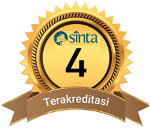| JOURNAL MENU |
| Jurnal History |
| Focus and Scope |
| Editorial Team |
| Reviewer |
| Publication Ethics |
| Author Guideline |
| Editorial Policy |
| Online Submission |
| Author Fees |
| ACCREDITATION |

Jurnal Bionature has been accredited by the Ministry of Research, Technology, and Higher Education, Republic of Indonesia, and gained the fourth grade from Science and Technology Index (SINTA 4) star from Vol 23 No (1) 2022 and valid until volume 27 No (2) 2026
| ISSN |


